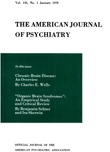NEUROSIS AND SOCIAL CLASS
Abstract
We advance the hypothesis that the diagnosis of neurosis is the resultant of an interaction process involving the patient, the doctor, and the social group. A psychiatric census shows that the prevalence of neurosis is positively correlated with social level and that there are important differences in method of referral of neurotics from the various social classes. [SEE SOURCE PDF FOR TABLE 5] By use of a psychological symptom scale, we describe a class configuration, ranging from subjective, introversive symptoms in the top classes to somatic complaints and behavioral difficulties in the lower classes. A social interaction index reveals that the locus of conflict progressed through increasingly wider areas of social dislocation—ranging from intrapersonal symptoms in Classes I and II to severe social and legal collisions in lower Classes IV and V. Correlation of all psychological symptoms and social interaction shows this consistent increase in social difficulties. The correlation of character disorder and social interaction illustrate these relationships in a striking manner.
Several operations now in process add to their significance: (a) Professional orientation of the psychiatrist, whether analytic, analytically oriented, or eclectic, is positively correlated with class; (b) patterns of symptoms are positively correlated with class; (c) symptom pattern and social interaction index are also being correlated.
From these findings, and from complementary results of the over-all investigation, we adduce that treated neurosis is a process within a social context which can be best understood by systematic observation not alone of the individual but of his interpersonal gestalt. Certain distinguishing characteristics of the social classes are reflected in the neurosis itself.
Access content
To read the fulltext, please use one of the options below to sign in or purchase access.- Personal login
- Institutional Login
- Sign in via OpenAthens
- Register for access
-
Please login/register if you wish to pair your device and check access availability.
Not a subscriber?
PsychiatryOnline subscription options offer access to the DSM-5 library, books, journals, CME, and patient resources. This all-in-one virtual library provides psychiatrists and mental health professionals with key resources for diagnosis, treatment, research, and professional development.
Need more help? PsychiatryOnline Customer Service may be reached by emailing [email protected] or by calling 800-368-5777 (in the U.S.) or 703-907-7322 (outside the U.S.).



